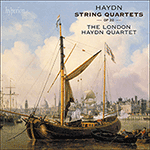
Welcome to Hyperion Records, a British classical label devoted to presenting high-quality recordings of music of all styles and from all periods from the twelfth century to the twenty-first.
Hyperion offers both CDs, and downloads in a number of formats. The site is also available in several languages.
Please use the dropdown buttons to set your preferred options, or use the checkbox to accept the defaults.

| The London Haydn Quartet» More |
The jewel of the quartet, some might even say of the entire Op 20 set, is the Affettuoso e sostenuto (‘Tender and sustained’), in the dusky key of A flat: music of self-communing inwardness that unfolds throughout in a hushed, rich, four-part chorale texture, with no discernible ‘theme’ and minimal articulation. There is something strangely elusive about this movement, with its weird interlocking and crossing of parts and quietly audacious dissonances. Mozart would remember it in the Andante, likewise in A flat, of his third ‘Haydn’ quartet, K428. The Presto finale is as economically fashioned as the first movement, drawing its quirky energy from its laconic opening theme (consisting of two three-bar phrases) and a series of syncopations that initiate an exciting sequence of modulations in the central development. Like Nos 3 and 4, the quartet ends in a whisper.
from notes by Richard Wigmore © 2011
Le joyau de ce quatuor, voire de tout l’op. 20, est l’Affettuoso e sostenuto («Tendre et tenu») sis dans un la bémol crépusculaire: une musique d’une intériorité en communion avec elle-même, qui se développe en une profonde et riche texture chorale à quatre parties, sans «thème» discernable et avec une articulation minimale. Avec ses curieux entrelacs et croisements de parties, mais aussi ses dissonances doucement audacieuses, ce mouvement a quelque chose d’étrangement insaisissable et Mozart s’en souviendra dans l’Andante, également en la bémol, de son troisième quatuor «Haydn» K428. Le finale Presto, aussi économe que le premier mouvement, tire sa bizarre énergie de son laconique thème d’ouverture (constitué de deux phrases de trois mesures) et d’une série de syncopes lançant une palpitante séquence de modulations dans le développement central. À l’instar des nos 3 et 4, ce quatuor s’achève dans un murmure.
extrait des notes rédigées par Richard Wigmore © 2011
Français: Hypérion
Das Juwel des Quartetts, nach Ansicht mancher sogar der gesamten Gruppe op. 20, ist das Affettuoso e sostenuto („Zärtlich und getragen“) in der dämmrigen Tonart As-Dur: Musik von mit sich selbst Zwiesprache haltender Innerlichkeit, die sich in einem durchweg gedämpften, prächtigen vierstimmigen Choralsatz ohne erkennbares „Thema“ und mit minimaler Artikulation entfaltet. Mit seinen merkwürdigen Stimmverschränkungen und kreuzungen sowie seinen still verwegenen Dissonanzen entzieht sich der Satz auf seltsame Weise dem Zugriff. Mozart sollte sich im Andante seines ebenfalls in As-Dur stehenden dritten Haydn-Quartetts KV 428 darauf zurückbesinnen. Das Finale im Presto ist ebenso ökonomisch angelegt wie der Kopfsatz und bezieht seine eigenwillige Energie aus dem kurzen und bündigen Eingangsthema (bestehend aus zwei Dreitaktphrasen) sowie aus einer Reihe von Synkopen, die in der zentralen Durchführung eine spannende Modulationssequenz in Gang setzen. Wie auch Nr. 3 und 4 schließt das Quartett im Flüsterton.
aus dem Begleittext von Richard Wigmore © 2011
Deutsch: Arne Muus
 Haydn: String Quartets Op 20 Haydn: String Quartets Op 20Haydn’s remarkable Opus 20 quartets are rightfully regarded as landmarks in the history of the string quartet. The six works are all individual masterpieces, revealing astonishing consistency and a huge variety of form and style, contrasting dynam ...» More |

